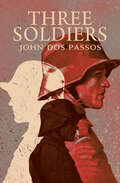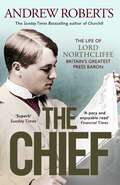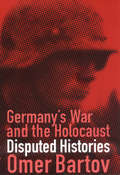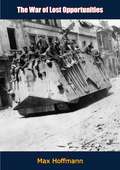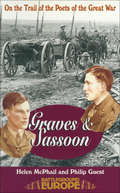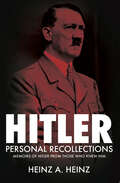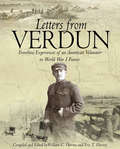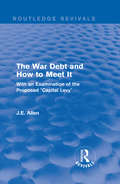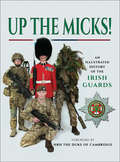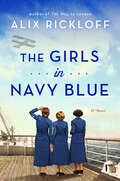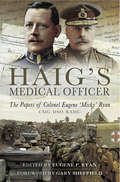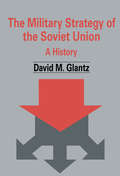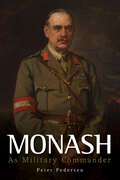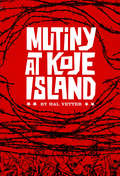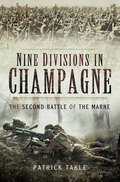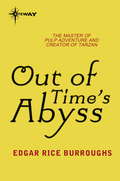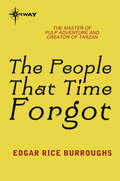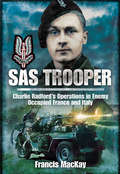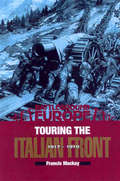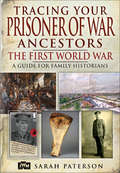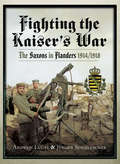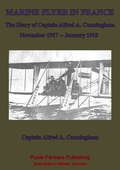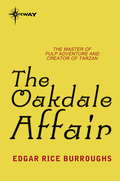- Table View
- List View
Three Soldiers (Barnes And Noble Library Of Essential Reading Ser.)
by John Dos PassosA grim portrait of World War I army life that set the standard for Hemingway, Mailer, and other acclaimed chroniclers of warfare. They come to the army from different Americas: Fuselli, a San Francisco store clerk bucking for promotion; Chrisfield, a laid-back Indiana farm boy; and Andrews, a Harvard graduate and promising New York City musician. In basic training, they are told it doesn&’t matter where a man is born or what he wants to be. The best soldiers are automatons. To be a perfect cog within a vast military machine is all his country asks of him. In the muddy fields and trenches of France, they learn the terrible meaning of their sacrifice: Once lost, a soldier&’s humanity can never be regained. Based on John Dos Passos&’s firsthand knowledge of the Great War, Three Soldiers is a grim and utterly realistic portrait of army life. A modernist masterpiece and a brave statement of fact in a time of sentiment, it set a standard that Hemingway, Jones, Mailer, O&’Brien, and every other chronicler of the American war experience has since tried to match. This ebook has been professionally proofread to ensure accuracy and readability on all devices.
The Chief: The Life of Lord Northcliffe Britain's Greatest Press Baron
by Andrew RobertsA definitive and compelling biography of Alfred Harmsworth, 1st Viscount Northcliffe (1865-1922), the greatest press magnate in history, the genius who invented modern popular journalism, and against whom all the other great newspaper proprietors must be measured. By the time of his tragically early death at 57 in August 1922, Northcliffe had founded the Daily Mail and Daily Mirror, and had also owned The Times and the Observer. At one point he owned two-thirds of all the titles on Fleet Street. He laid down the essential features of British popular journalism that we see now. He was a tough and uncompromising businessman, but in The Chief Andrew Roberts puts his ruthlessness and wilfulness in the overall context of a life of visionary business skill, journalistic brilliance, distinguished wartime public service and heartfelt patriotism. From a modest background, growing up on the outskirts of Dublin, by 27 he presided over a magazine empire with the largest circulation in the world. He wanted his readers to know that he was on their side, which they instinctively did. He was proud of his populist approach, saw the importance of appealing to both sexes in his pages, and allowed his editors leeway so long as they understood and followed his vision. The formula he created for the Daily Mail is still world-beating to this day. Based on exclusive access to the Harmsworth family archive, The Chief is a compelling and essential portrait of a man who changed the way we learn about the news, and whose influence still resonates today.
Germany's War and the Holocaust: Disputed Histories
by Omer BartovWhile attempts to come to terms with past catastrophe . . . can help prevent its recurrence, they may also provide arguments for . . . actions against the real or imagined perpetrators of previous disasters. The confrontation with . . . catastrophe can help us understand the roots and nature of this century's destructive urges, as well as humanity's extraordinary recuperative capacities; but it can also legitimize the perpetuation of violence and aggression. -from the Introduction Omer Bartov, a leading scholar of the Wehrmacht and the Holocaust, provides a critical analysis of various recent ways to understand the genocidal policies of the Nazi regime and the reconstruction of German and Jewish identities in the wake of World War II. Germany's War and the Holocaust both deepens our understanding of a crucial period in history and serves as an invaluable introduction to the vast body of literature in the field of Holocaust studies. Drawing on his background as a military historian to probe the nature of German warfare, Bartov considers the postwar myth of army resistance to Hitler and investigates the image of Blitzkrieg as a means to glorify war, debilitate the enemy, and hide the realities of mass destruction. The author also addresses several new analyses of the roots and nature of Nazi extermination policies, including revisionist views of the concentration camps. Finally, Bartov examines some paradigmatic interpretations of the Nazi period and its aftermath: the changing American, European, and Israeli discourses on the Holocaust; Victor Klemperer's view of Nazi Germany from within; and Germany's perception of its own victimhood.
The War of Lost Opportunities (Great War Ser. #Vol. 75)
by Max HoffmannFirst published in 1924, German General Max Hoffmann’s The War of Lost Opportunities examines missed opportunities for the German military during the First World War.The book takes particular note of The Battle of Tannenberg fought between August 26-30, 1914, which resulted in the almost complete destruction of the Russian Second Army and the suicide of its commanding general, Alexander Samsonov.The battle also led to the 1918 Spring Offensive—otherwise known as Kaiserschlacht (“Kaiser’s Battle”), or the Ludendorff Offensive—which saw a series of German attacks along the Western Front, beginning on 21 March 1918, that marked the deepest advances by either side since 1914.An invaluable addition to any First World War book collection.
Christopher And Columbus: A Virago Modern Classic (Virago Modern Classics #392)
by Elizabeth von ArnimAs the First World War looms, Anna-Rose and Anna-Felicitas, seventeen-year-old orphan twins, are thrust upon relatives. But Uncle Arthur, a blustering patriot, is a reluctant guardian: the twins are half-German and, who knows, they could be spying from the nursery window... Packed off to America, they meet Mr Twist, a wealthy engineer with a tendency to motherliness, who befriends them on the voyage. However, he has failed to consider the pitfalls of taking such young and beautiful women under his wing, especially two who will continue to require this protection long after the ship has docked, and who are incapable of behaving with tact. Many adventures ensue (and befall them) in this sparklingly witty, romantic novel in which Elizabeth von Armin explores the suspicions cast upon the two Annas and Mr Twist in a country poised for war.
Graves & Sassoon: On the Trail of the Poets of the Great War (Battleground Europe)
by Helen McPhail Philip GuestThe war memoirs of these two officers with the Royal Welsh Fusiliers have never been out of print since their first publication. Both men won instant and enduring fame with these very different narratives, which made them two of the most influential participants in shaping later attitudes to the war. Graves gave offence in many quarters with his factual inaccuracies and/or slurs on various units of the British Army. Sassoon's nostalgic evocation of his cricketing and fox-hunting background contrast with the detailed narrative of personalities and life in the Battle of the Somme and the Battle of Arras. The thinly disguised names of real fellow officers are unravelled to help illustrate Sassoon's poetry and actions.
Hitler: Memoirs of Hitler From Those Who Knew Him
by Heinz A. HeinzHeinz A. Heinz was the only writer authorised by the Nazi Party to draw a biography of the Fhrer for publication in the English speaking world. The result was the 1938 authorised biography of Adolf Hitler entitled Germany's Hitler.The book was based on interviews supplied first hand by those friends, helpers and comrades who had believed in him from the beginning of his political career. Heinz A. Heinz was a professional journalist and author, he interviewed Hitler's old school friends, army colleagues, landlords, his jailer, and early party comrades including an invaluable interview with Anton Drexler to produce an unprecedented insight into Adolf Hitler as viewed by his acquaintances during the inter-war period.These remarkable interviews were given by those who had stood by him in his darkest days, and who lived to see one of the most astounding political achievements in history. Included are vivid and unique descriptions of Hitler at school, his First World War battlefield experiences, the early political struggles, the full story behind the 9th November Beer Hall Putsch, Hitler in prison, and the struggle to power from 1926 to 1933.Featuring a new introduction by Emmy Award winning writer and historian Bob Carruthers, this book is a vital primary source reference work for anyone interested in understanding how and why Hitler won the total adulation and support of such a large section of the German people.
Letters from Verdun: Frontline Experiences of an American Volunteer in World War I France
by Avery Royce WolfeThe dramatic experiences of an ambulance driver in the Great War, told through personal correspondence and photographs.Though the United States was late to enter the Great War, a number of idealistic young Americans wished to take part from the beginning. One of these was Avery Royce Wolf, a highly educated scion of a family in America’s burgeoning industrial heartland.Volunteering as an ambulance driver with the French Army in the Verdun sector, Royce sent back a constant stream of highly detailed letters describing the experience of frontline combat, as well as comments on strategy, the country he encountered, and the Allies’ prospects for success.This treasure trove of brilliant letters, only recently discovered, is accompanied by several albums worth of rare, high-quality photos depicting aspects of the Great War in France never previously published. Full of action, including the suspense and terror of the Ludendorff Offensive, as well as interesting firsthand analyses such as comparing French and German trench works, Letters from Verdun brings the reader amazingly close to the frontlines of the Great War.
Routledge Revivals (1919): With an Examination of the Proposed "Capital Levy"
by J.E. AllenFirst published in 1919, this book traces the growth of War Debt during the First World War, examines the real meaning of the Debt and discusses the proposals for clearing it. As the chief contemporary proposal put forward for meeting the interest and repaying the principal of the Debt was the "Conscription of Wealth", or the "Capital Levy", this provides a main focus for the analysis. The author also examines whether the methods of financing war — by borrowing the required money — is sound and whether it should be replaced by taxation. A plan for the reform of income tax is put forward, designed to yield two-thirds of the revenue needed for a Peace Budget that also addresses the War Debt.
Up the Micks!: An Illustrated History of the Irish Guards
by James WilsonThe unique history of The Micks – the Irish Guards – is chronicled in over 1000 images, starting with their formation in 1900 and taking the reader through to the recent war in Afghanistan. It is the story of a remarkable family regiment that continues to enhance the values, standards and reputation of the British infantry in an ever-changing world. The two world wars are covered in detail with dramatic pictures. The First World War – the brick stacks at Cuinchy under fire, where O&’Leary won his VC – and the Second World War – the inferno of the transport ship Chobry off the coast of Norway and the first ever German King Tiger tank seen in action brought to a halt by the Irish Guards without firing a shot. More recently, the Micks were involved in internal security duties in Palestine, Cyprus, Malaya, Aden, Northern Ireland and the Balkans. They led the way into Iraq in the Second Gulf War and shed blood in Afghanistan. The book shows the development of regimental soldiering from the rigidity of the Victorian era, through the horrors of the trenches to armoured warfare in Europe and light infantry soldiering worldwide – all the time upholding the finest traditions of the Foot Guards. In an army that prides itself on the strength of the regimental system, the Irish Guards have created a distinctive and enduring ethos of their own. This is not just a cold regimental history but has been compiled to show the Micks&’ ability to find humour even in the most adverse conditions while demonstrating excellence at both operational and ceremonial soldiering. It also contains, in an extensive set of appendices, a remarkable record of facts about the regiment – the people, places and events in the history of the Irish Guards – which will serve as an invaluable source of information for future generations.
The Girls in Navy Blue: A Novel
by Alix RickloffA gripping and compelling dual timeline novel about three women who joined the Navy during WWI to become yeomanettes and the impact their choices have on one of their descendants in 1968."The Girls in Navy Blue had me smiling from first page to last! When the US Navy admits women to the ranks during World War I, three intrepid yeomanettes answer the call: Blanche the dashing suffragette, Marjory the German immigrant, and Vivian the preacher's daughter on the run from the police. Friendship, duty, and the struggle of making their way in a man's world will bind the three together, and their secrets will resound through the next fifty years--until Blanche's great-niece, reeling from losses and desperate for home, will pick up the pieces. Alix Rickloff pens a lovely coming-of-age tale: brave women making waves in a war-torn world." - Kate Quinn, New York Times bestselling author1918 - America is at war with Germany, and, for the first time in history, the US Navy has allowed women to join up alongside the men. Ten thousand of them rush to do their part. German-American Marjory Kunwald enlists in the Navy to prove her patriotism. Suffragette Blanche Lawrence to prove that women are the equal of men. And shy preacher’s daughter Viv Weston in a desperate attempt to hide from the police. Even as the US military pours into France and the war heats up, the three yeomanettes find friendship and sisterhood within the Navy. But all their plans for the future are thrown into chaos when Viv’s dark past finally catches up with her.1968 - Newly divorced and reeling from a personal tragedy, Peggy Whitby unexpectedly inherits her estranged great-aunt Blanche’s beach cottage outside Norfolk Virginia. But her fragile peace is rattled when she begins to receive mysterious postcards dated from 1918 when Blanche served as a Navy yeomanette. Curious to learn more about her mysterious aunt and uncover the truth behind the cryptic messages, Peggy is drawn deeper into the lives of the three young Navy girls. But her digging uncovers more than she bargains for, and, as past and present collide, Peggy must decide if finding out about her aunt is worth the risk of losing herself.
Haig's Medical Officer: The papers of Colonel Eugene 'Micky' Ryan CMG DSO RAMC
by Eugene RyanDespite countless conflicting assessments, Field Marshal Douglas Haig remains one of the most controversial and fascinating characters in British military history. To some he was a mindless butcher, to others a true patriot who masterminded Allied victory in the First World War under the most trying circumstances.The papers of Colonel Eugene 'Micky' Ryan, Haig's long serving doctor and confidant, are a significant find as they throw fresh and invaluable light on the life and character of this enigmatic man. Ryan studied medicine at Cork and Edinburgh. He was commissioned into the RAMC in 1901 and saw active service in South Africa. He first met Haig in 1912 and became Medical Officer to Haig's HQ 1st Corps in 1914 and moved with him to 1st Army that December. Ryan saw service commanding two Casualty Clearing Stations before being appointed Medical Officer to the C in C (Haig) in September 1916.Haig's and Ryan's relationship, while primarily professional, blossomed into a friendship of mutual respect and trust which lasted until Haig's death in 1928. Ryan delivered the Haigs' long awaited heir, Dawyck, in 1918 and advised during Dorothy Haig's illness in 1926.Fortunately Ryan kept meticulous diaries which, written from such a unique viewpoint and with constant reference to Haig and his family, are of historical importance: the Foreword, written by Professor Gary Sheffield a leading authority on Haig's life and work, attests to their significance.As seen in Britain at War Magazine, January 2014
The Military Strategy of the Soviet Union: A History (Soviet (Russian) Military Theory and Practice #No. 6)
by David M. GlantzArmed revolution and civil war gave birth to the Soviet Union, world War II propelled it to global pre-eminence, and the Cold War contributed to the Soviet Union's demise. Given Marxism-Leninism's idological preoccupation with war and threats of war, it is understandable that the spectre of war should play a vital role in the life and fate of the Soviet state.This study of Soviet military strategy is based upon the twin pillars of Soviet political-military actions and Soviet writings on the subject of military strategy. Thanks to the policy of glasnost, it incorporates Soviet materials hitherto unavailable in the West. It aims to be not simply a retrospective account of what was, but to form part of the context for what will be in the future.
Monash: As Military Commander
by Dr. Peter PedersenDr Peter Pedersen&’s scholarly study of Sir John Monash remains the finest analysis of Australia&’s best known military leader. In 1918 the Australian Corps under Monash&’s command played a leading role in the Allied advance to victory on the Western Front. Its successes in the battles of Hamel and Amiens, the taking of Mont St Quentin and Péronne and the breaching of the Hindenburg Line are among the most prominent landmarks in Australia&’s military history. Monash was central to these pivotal achievements. This book traces Monash&’s development as a commander from his pre-war militia service to his wartime experience at Gallipoli and on the Western Front. It examines in detail how each stage of his military career influenced his approach to command and the tactical problems he faced as the wartime commander of an infantry brigade and division and, ultimately, the Australian Corps. The influence of his education and civilian training are also examined in this meticulous study. What emerges from this nuanced and sophisticated assessment of Monash as a soldier is a superb portrayal of how a commander works and what he could achieve under conditions so inimical to the exercise of command as those that prevailed on the Western Front. Along the way, Dr Pedersen establishes Monash&’s place among his contemporaries, British and Australian, and provides the definitive answer to the question &‘Just how good was Monash?&’ Published for the centenary of the great victories of 1918, this new and updated edition of Dr Pedersen&’s classic work is a timely study of Australia&’s finest general.
Mutiny at Koje Island
by Hal VetterThis absolutely authentic, horrifying account of treachery, intrigue and ruthless brutality among 150,000 Communist POWs herded together on the small rugged island of Koje-do in Korea, tells of their holding the American commander as hostage and of their ultimate vicious mutiny, armed with thousands of improvised spears, gasoline grenades, and knives, and with countless barbed-wire flails.This is a now-it-can-be-told book that no American can read without becoming shocked and fighting mad. On the other hand no American can read the transcripts of the proceedings at Panmunjom without a deep feeling of respect and admiration for the distinguished military leaders of the United Nations to whom our national honor was entrusted. Their dignity, patience, and forbearance in the performance of a bleak, unrewarding task deserve the commendation of each and every citizen of the free world community.
Mutiny at Koje Island
by Hal VetterThis absolutely authentic, horrifying account of treachery, intrigue and ruthless brutality among 150,000 Communist POWs herded together on the small rugged island of Koje-do in Korea, tells of their holding the American commander as hostage and of their ultimate vicious mutiny, armed with thousands of improvised spears, gasoline grenades, and knives, and with countless barbed-wire flails.This is a now-it-can-be-told book that no American can read without becoming shocked and fighting mad. On the other hand no American can read the transcripts of the proceedings at Panmunjom without a deep feeling of respect and admiration for the distinguished military leaders of the United Nations to whom our national honor was entrusted. Their dignity, patience, and forbearance in the performance of a bleak, unrewarding task deserve the commendation of each and every citizen of the free world community.
Nine Divisions in Champagne: The Second Battle of Marne
by Patrick TakleThe book explains how the Allies, after a series of swingeing defeats, sank their differences and came together to turn the tide against the German Army in the Summer of 1918. Although it is a detailed history of the fighting by British divisions, it also highlights the growing presence of American forces and their huge contribution to victory, too often understated in earlier works. The book deliberately binds together the genesis, size and equipment of the British and American divisions and seeks to inter-mingle the American and British campaigns of 1918.By blocking the Third German Offensive on the Chemins des Dames and then arriving in time to turn the Kaiser's army out of the Marne salient, the Allied divisions cleared the way for the decisive counter offensive at Amiens. Exhausted and demoralized, the German Army collapsed and the outcome of The Great War was decided.
Out of Time's Abyss: Land That Time Forgot Book 3
by Edgar Rice BurroughsThe third book in Burrough's Caspak series-which also includes The Land That Time Forgot and The People That Time Forgot-Out of Time's Abyss is fully enjoyable as a standalone tale. Here, Bradley, survivor of an earlier expedition to the lost continent of Caspak, near Antarctica, has been sheltered at Fort Dinosaur, and now decides to brave the dangers of the land's barbarian men and brutal dinosaurs in an attempt to get home to England.
The People That Time Forgot: Land That Time Forgot Book 2
by Edgar Rice BurroughsIn uncharted Caprona, a continent lost from the map of Earth, where Time had stopped and all the primeval creatures of long-gone ages still prowled, Bowen Tyler was lost.Strange mysteries awaited the expedition that went in search of Tyler. A barbaric, warring civilization hid there, trapped between the impassable jungle on one side and an unknown menace on the other.
SAS Trooper: Charlie Radford's Operations in Enemy-Occupied France and Italy
by Francis MackayA prewar Sapper, Charlie Radford served in North Africa until he returned to the UK for parachute training. He volunteered and joined 2 SAS in Scotland. His first operation was in France (Op RUPERT) cutting railway lines, and he then took park in Operation LOYTON, now in armed jeeps. His next assignment (Operation ZOMBIE) involved parachuting into the Italian Dolomites to disrupt the vital German link north of Verona between Italy and Austria.This operation ended in failure due to foolhardy leadership, inadequate manning and poor preparation. His OC was captured, tortured and executed but Charlie escaped to live with the partisans before being repatriated to the UK. After the war he returned to France to help with the exhumation and reburial of SAS men executed in the Vosges mountains. Postwar he served in Kenya and Somaliland and briefly recounts his experiences.
Touring the Italian Front, 1917–1919 (Battleground Europe)
by Francis MackayThe guide describes the ground and operations covered by the British, French and US Expeditionary Forces deployed from France to the area North of Venice between November 1917 and Spring 1919. These Forces supported the Italians after their disastrous defeat at Caporetto and helped stem the Austrian and German onslaught.This is the first guide to the Allied contribution and the Piave Defence line. It also covers the rear areas - supply and repair services, training and recreation, and describes the movement to Italy and subsequent service and care of the 16,000 British and 20,000 French horses and mules. The US contribution has never been adequately described before.
Tracing Your Prisoner of War Ancestors: The First World War (Tracing Your Ancestors)
by Sarah PatersonThe experience of civilian internees and British prisoners of war in German and Turkish hands during the First World War is one of the least well-known and least researched aspects of the history of the conflict. The same applies to prisoners of war and internees held in the UK. Yet, as Sarah Paterson shows in this authoritative handbook, a wide-range of detailed and revealing information is available if you know where to look for it.Briefly she outlines the course of the campaigns in which British servicemen were captured, and she describes how they were treated and the conditions they endured. She locates the camps they were taken to and explains how they were run. She also shows how this emotive and neglected subject can be researched - how archives and records can be used to track down individual prisoners and uncover something of the lives they led in captivity.Her work will be an essential introduction for readers who are keen to get an insight into the experience of a POW or an internee during the First World War, and it will be an invaluable guide for anyone who is trying to trace an ancestor who was captured.
Fighting the Kaiser's War: The Saxons in Flanders, 1914/1918
by Andrew Lucas Jürgen SchmieschekPersonal accounts of the Great War experiences of British soldiers are well known and plentiful, but similar accounts from the German side of no man's land are rare. This highly original book vividly describes the wartime lives and ultimate fates of ten Saxon soldiers facing the British in Flanders, revealed through their intimate diaries and correspondence. The stories of these men, from front-line trench fighters to a brigade commander, are in turn used to illustrate the wider story of thousands more who fought and died in Flanders 'for King and Country, Kaiser and Reich' with the Royal Saxon Army. This ground-breaking work is illustrated with over 300 mostly unseen wartime photographs and other images, recording the German experience of the war in human detail and giving a rounded picture of how the Saxons lived and died in Flanders.
Marine Flyer In France — The Diary Of Captain Alfred A. Cunningham, November 1917 - January 1918
by Captain Alfred Austell CunninghamDuring November and December 1917, Captain Alfred A. Cunningham, the first Marine Corps aviator, travelling under orders from Major General Commandant George Barnett, toured the battlefronts and flying fields of France to observe Allied air operations and training.The diary, kept in tiny, neat handwriting in a small pocket notebook, begins on 3 November 1917 with Cunningham's sailing from New York on board the S. S. St. Paul. After a description of a rough winter passage through the North Atlantic U-boat zone, the entries record the confusion, inconveniences, and hardships of wartime London and Paris and contain repeated expressions of homesickness, along with sometimes acid comment on the French people and culture. His tour of British and French airfields culminated with his flying a number of the different aircraft then in service, even flying himself with French airmen on combat missions in December 1917.
The Oakdale Affair
by Edgar Rice BurroughsThe beautiful young daughter of a wealthy family is robbed of her money and jewels, and she herself disappears soon after... A young man fleeing a band of murderous hobos becomes the target of a lynch mob... Frozen to silent rigidity, they sat straining every faculty to catch the minutest sound from the black void where the dead man lay. As they listened there came up to them, mingled with inexplicable footsteps, a hollow reverberation from the dank cellar - a hideous dragging of chains behind the nameless horror which had haunted them through the interminable eons of the ghastly night. Up, up it came toward the room at the head of the stairs where they huddled fearfully. They could now hear quite clearly what might have been the slow and ponderous footsteps of a heavy man dragging painfully across the rough floor. It stopped in front of their hideout and all was silent. Suddenly their rang out against the silence of the awful night a piercing shriek, and a great The Oakdale Affair force began to bend the flimsy door...
